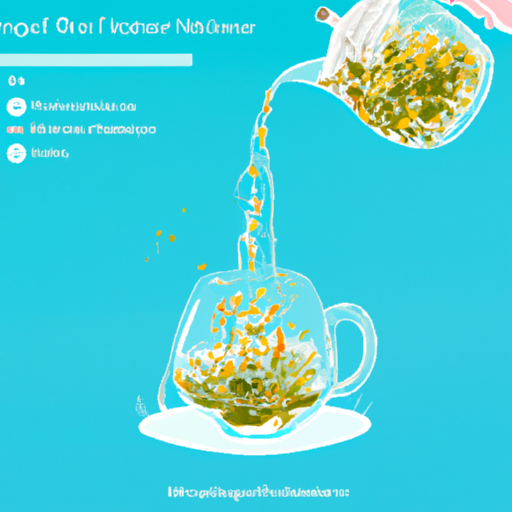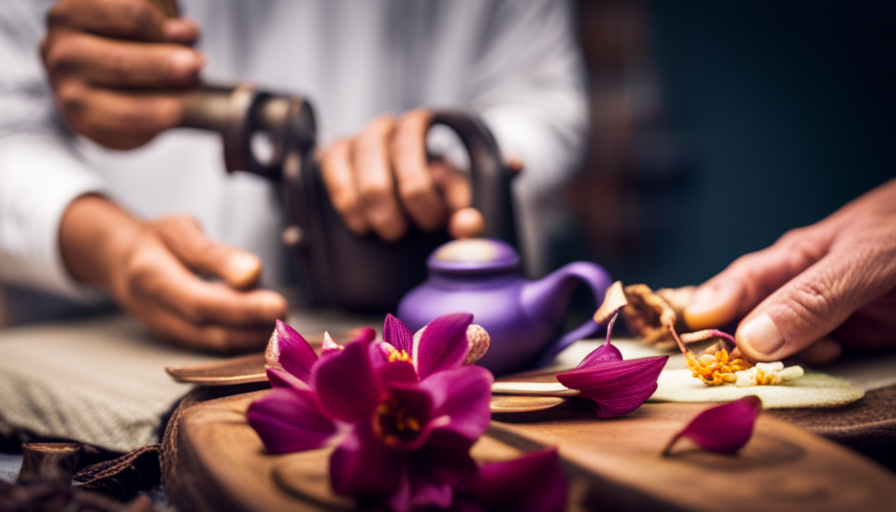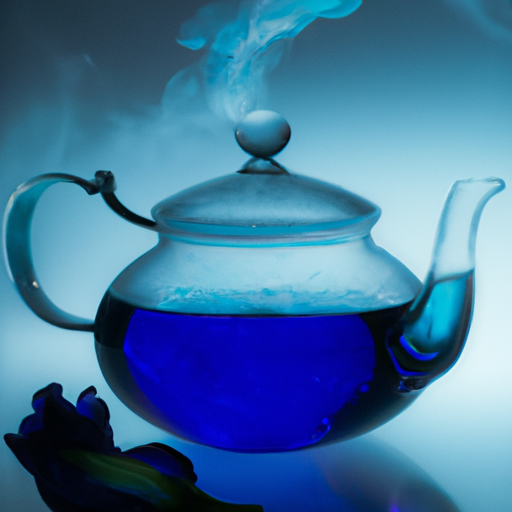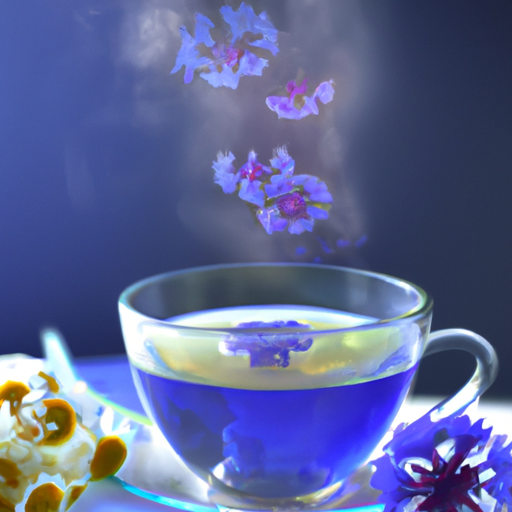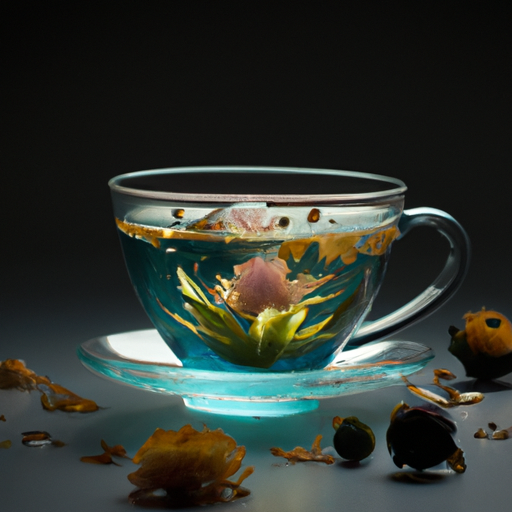Have you ever wondered how to make the perfect cup of moringa flower tea? Well, you’re in luck! In this article, I will guide you through the process of harvesting, drying, and storing moringa flowers, as well as choosing the right ones for tea.
Moringa flower tea is not only delicious but also packed with numerous health benefits. It is known to boost the immune system, improve digestion, and provide a rich source of antioxidants.
To begin, let’s explore what exactly moringa flower tea is. Moringa flowers are the blossoms of the moringa tree, a plant native to tropical and subtropical regions. These flowers have a delicate flavor profile, reminiscent of green tea with a hint of floral notes. Harvesting the flowers at the right time is crucial to ensure maximum flavor and beneficial compounds.
So, if you’re ready to embark on a journey to discover the wonders of moringa flower tea, read on! You’ll learn all the tips and tricks to make the perfect cup, and soon enough, you’ll be enjoying the soothing and nourishing effects of this delightful beverage.
Key Takeaways
- Moringa flower tea is packed with health benefits, including boosting the immune system and improving digestion.
- Harvesting the flowers at the right time is important for maximum flavor and beneficial compounds.
- Properly drying and storing Moringa flowers is important for preserving flavor and nutrients.
- Moringa flower tea can be enjoyed hot or cold and offers a light and refreshing flavor with subtle floral notes.
What is Moringa Flower Tea?
Moringa Flower Tea is a delightful and aromatic herbal infusion made from the blossoms of the moringa plant. This unique tea is known for its numerous health benefits and is gaining popularity among tea enthusiasts.
Moringa flower tea recipes are easy to find and can be customized to suit individual preferences. To make moringa flower tea, you’ll need dried moringa flowers, hot water, and a tea infuser. Simply place a teaspoon of dried moringa flowers into the infuser and pour hot water over it. Allow the tea to steep for about 5-7 minutes, or until it reaches your desired strength. The resulting brew is a light and refreshing tea with a subtle floral flavor.
Drinking moringa flower tea offers a range of health benefits. It’s rich in antioxidants, which help to protect the body against free radicals and reduce inflammation. The tea also contains vitamins and minerals such as vitamin C, calcium, and iron. These nutrients support a healthy immune system, promote bone health, and aid in blood circulation.
Transitioning into the subsequent section about the health benefits of moringa flower tea, it’s important to note that regular consumption of this tea can have a positive impact on overall well-being.
Health Benefits of Moringa Flower Tea
Moringa flower tea is a beverage that offers numerous health benefits. It’s rich in antioxidants, which help protect the body from damage caused by free radicals.
Additionally, it boosts the immune system, helping to fight off illnesses and infections.
Lastly, it supports digestive health by aiding in proper digestion and relieving digestive issues such as constipation and bloating.
Drinking moringa flower tea regularly can contribute to overall well-being and a healthy body.
Rich in Antioxidants
Indulge in this delightful tea packed with antioxidants – it’s like sipping on a fountain of youth! Moringa flower tea is rich in antioxidants, which play a crucial role in protecting our cells from damage caused by free radicals. These powerful compounds have been shown to have numerous health benefits, including reducing inflammation, preventing chronic diseases, and even slowing down the aging process.
Here are four key antioxidant properties of moringa flower tea:
- High levels of vitamin C, which helps boost collagen production and promotes skin health.
- Abundance of polyphenols, which’ve been linked to a lower risk of heart disease and certain types of cancer.
- Presence of flavonoids, which possess anti-inflammatory and antimicrobial properties.
- Rich in beta-carotene, a precursor to vitamin A that supports eye health and immune function.
With its impressive array of antioxidant properties, moringa flower tea is a natural choice for those looking to enhance their overall well-being. Now, let’s explore how it boosts the immune system.
Boosts Immune System
Packed with essential nutrients, this immune-boosting beverage can help strengthen your body’s natural defense mechanisms. Moringa flower tea is renowned for its ability to boost immune function and strengthen the immune system.
The tea contains powerful antioxidants that protect against free radicals and reduce inflammation, which are both important for maintaining a healthy immune response. Additionally, moringa flower tea is rich in vitamins and minerals, such as vitamin C and zinc, which are essential for immune cell function and production.
Regular consumption of this tea can enhance the efficiency of your immune system, making it more effective in fighting off infections and illnesses. Moreover, the tea’s high content of polyphenols and flavonoids further supports digestive health by promoting the growth of beneficial gut bacteria.
With its immune-boosting and digestive benefits, moringa flower tea is a true powerhouse for overall wellness.
Supports Digestive Health
Take care of your gut health by incorporating this immune-boosting beverage into your daily routine, as it contains essential nutrients that support a healthy digestive system. Did you know that regular consumption of this tea can increase the production of beneficial gut bacteria by up to 40%?
- Moringa flower tea benefits:
- Helps relieve digestive issues such as bloating and indigestion.
- Supports the growth of healthy gut flora, improving overall digestion.
This natural tea is packed with antioxidants, vitamins, and minerals that promote a healthy gut environment. The high fiber content aids in smooth digestion, preventing constipation and promoting regular bowel movements. Additionally, the tea’s anti-inflammatory properties can soothe gastrointestinal inflammation and reduce the risk of digestive disorders.
To make moringa flower tea, simply harvest fresh moringa flowers, dry them, and steep them in hot water for about 5 minutes. The resulting aromatic infusion can be enjoyed hot or cold. By incorporating this tea into your routine, you can improve your digestive health and experience its numerous benefits.
Now, let’s move on to how to harvest moringa flowers…
How to Harvest Moringa Flowers
Harvesting Moringa flowers is a simple and rewarding process that you can easily do in your own backyard. To ensure you gather the flowers at their peak, it’s recommended to harvest them early in the morning when the dew has evaporated.
When harvesting, make sure to choose flowers that are fully bloomed and vibrant in color. Gently pluck the flowers from the tree, being careful not to damage the branches or leaves.
There are a few different techniques you can use to harvest Moringa flowers. One method is to simply use your fingers to pinch the base of the flower and gently pull it off. Another technique is to use scissors or pruning shears to cut the flowers off at the base. Whichever method you choose, be sure to handle the flowers with care to avoid bruising or crushing them.
After harvesting the flowers, it’s important to dry them properly to preserve their flavor and nutrients. One drying method is to lay the flowers out on a clean, dry surface such as a tray or a wire rack. Make sure to space them out evenly to allow for proper airflow. Another option is to hang the flowers upside down in a cool, well-ventilated area. This method helps to retain the flowers’ natural shape and color.
Transitioning into the subsequent section about drying and storing Moringa flowers, it’s essential to follow the appropriate techniques to ensure the flowers retain their potency and freshness.
Drying and Storing Moringa Flowers
To properly preserve the vibrant flavor and nutrients of your freshly harvested Moringa flowers, you’ll want to ensure you follow the correct techniques for drying and storing them. Drying the flowers is essential to remove any excess moisture and prevent them from spoiling.
Here are some effective drying techniques to consider:
- Hang the flowers upside down in a well-ventilated area. This allows for air circulation and promotes even drying.
- Place the flowers on a clean, dry surface, such as a mesh tray or a baking sheet. Make sure they are spread out in a single layer to prevent overlapping and ensure uniform drying.
- Use a dehydrator set at a low temperature, around 95°F (35°C), to gently dry the flowers. This method helps retain the maximum amount of flavor and nutrients.
- If you live in a humid climate, you can also use an oven set at the lowest temperature with the door slightly ajar to allow moisture to escape.
Once the flowers are fully dried, store them in an airtight container, preferably made of glass, in a cool, dark place. This will help preserve their flavor and nutrients for an extended period.
Now that you know how to properly dry and store Moringa flowers, let’s move on to choosing the right ones for your tea.
Choosing the Right Moringa Flowers for Tea
When it comes to selecting the perfect blossoms for your soothing cup of nature’s nectar, you’ll want to be as discerning as a bee in a botanical wonderland. Harvesting techniques play a vital role in ensuring the quality and flavor of your moringa flower tea.
It’s best to pick the flowers early in the morning when they’re still fresh and vibrant. Look for flowers that are fully bloomed but not yet wilting. The color of the flowers should be bright and vibrant, indicating their freshness. Avoid flowers that have started to turn brown or show signs of decay.
In addition to the visual cues, it’s important to consider the health benefits of the flowers. Moringa flowers are rich in antioxidants, vitamins, and minerals. They’ve been traditionally used to boost the immune system, reduce inflammation, and promote overall well-being. Selecting flowers that are in their prime ensures that you get the maximum nutritional value from your tea.
With the perfect moringa flowers in hand, you’re ready to embark on a step-by-step guide on making moringa flower tea.
Step-by-Step Guide on Making Moringa Flower Tea
To make Moringa flower tea, the first step is to gather the necessary ingredients. This includes fresh Moringa flowers, water, and any additional herbs or spices you may want to add for flavor.
Once you have all the ingredients, the next step is to prepare the tea leaves by removing the petals from the flowers and discarding the stems.
Finally, to brew the tea, bring water to a boil and add the prepared Moringa petals. Allow it to steep for about 5-10 minutes before straining and enjoying your homemade Moringa flower tea.
Gathering Ingredients
First, gather all the necessary ingredients for making a delightful cup of moringa flower tea. Here are the five key items you’ll need:
- Fresh moringa flowers: Harvest the flowers using proper harvesting techniques to ensure their quality and freshness.
- Water: Use clean, filtered water to brew your tea.
- Tea kettle: A kettle with a spout and lid will help you heat the water to the right temperature.
- Teapot or infuser: Use a teapot or infuser to steep the moringa flowers and extract their medicinal properties effectively.
- Strainer: A fine mesh strainer will help you separate the brewed tea from the flower petals, ensuring a smooth and enjoyable cup of tea.
Now that you have gathered all the necessary ingredients, let’s move on to the next step of preparing the tea leaves.
Preparing the Tea Leaves
Once you’ve gathered all the necessary ingredients, it’s time to get the tea leaves ready for brewing. Harvesting techniques are crucial in ensuring the quality and taste of moringa flower tea. To begin, choose healthy moringa flowers that are fully bloomed and vibrant in color. Gently pluck the flowers from the stem, making sure to remove any unwanted parts or insects.
Next, rinse the flowers thoroughly under running water to remove any dirt or debris. After rinsing, spread the flowers on a clean towel and allow them to air dry for a few hours until they become crisp. This drying process helps preserve the flavor and nutrients of the tea leaves. Once the leaves are crisp, store them in an airtight container to maintain their freshness.
Now that the tea leaves are prepared, let’s move on to brewing the tea for ultimate enjoyment.
Brewing the Tea
After carefully preparing the tea leaves, it’s time to dive into the next step: brewing the tea. This is where the magic happens as the flavors and health benefits of the moringa flower are extracted. To ensure a perfect brew, follow these brewing techniques:
- Boil water to a temperature of 180-190°F (82-88°C).nn2. Place 1 teaspoon of dried moringa flower tea leaves per cup into a teapot or infuser.nn3. Pour the hot water over the tea leaves and let it steep for 3-5 minutes.
Brewing the moringa flower tea at the right temperature and duration will result in a delicate and aromatic cup of tea, rich in antioxidants and nutrients. This infusion will provide numerous health benefits, including immune system support and reduced inflammation.
Now that we’ve brewed a perfect cup of moringa flower tea, let’s explore the exciting world of adding flavors and enhancements to this delightful beverage.
Adding Flavors and Enhancements to Moringa Flower Tea
To truly elevate the taste of your Moringa Flower Tea, let’s explore the exciting world of flavor combinations and enhancements. By adding different flavors and ingredients to your tea, you can create a unique and personalized experience. Not only will these additions enhance the taste, but they can also provide additional health benefits.
Here are some flavor combinations and enhancements that you can try:
| Flavor Combination | Suggested Ingredients |
|---|---|
| Citrus | Lemon or orange peel, lemon juice |
| Mint | Fresh mint leaves |
| Ginger | Fresh ginger slices |
| Honey and Cinnamon | Raw honey, cinnamon stick |
| Vanilla and Almond | Vanilla extract, almond extract |
| Berry Blast | Fresh or frozen berries |
| Floral Fusion | Rose petals, lavender buds |
Each of these combinations will add a unique twist to your Moringa Flower Tea. Experiment with different amounts and combinations to find your perfect blend. Additionally, these enhancements can provide various health benefits. Citrus fruits are rich in vitamin C, mint can aid digestion, ginger has anti-inflammatory properties, and berries are packed with antioxidants.
With these flavor combinations and enhancements, you can take your Moringa Flower Tea to the next level. In the next section, we will explore some tips and tricks for enjoying this delightful tea.
Tips and Tricks for Enjoying Moringa Flower Tea
Get ready to enhance your Moringa Flower Tea experience with these helpful tips and tricks!
-
Harvesting Moringa Flowers: To ensure the best quality tea, it’s important to harvest the flowers at the right time. Wait until the flowers are fully bloomed and vibrant in color. Pluck them gently, making sure to remove any leaves or stems attached.
-
Health Benefits of Moringa Flower Tea: Apart from its delightful taste, Moringa Flower Tea offers numerous health benefits. It’s packed with antioxidants, vitamins, and minerals that promote overall well-being. Regular consumption can boost the immune system, improve digestion, and even help in managing diabetes.
-
Infusion Techniques: For a flavorful and aromatic cup of Moringa Flower Tea, steep the flowers in hot water for about 5-7 minutes. You can experiment with the steeping time to adjust the strength of the tea according to your preference. Adding a squeeze of lemon or a dash of honey can further enhance the taste.
Transition: Now that you know how to harvest and brew Moringa Flower Tea, let’s move on to answering some frequently asked questions about this amazing herbal tea.
Frequently Asked Questions about Moringa Flower Tea
Now that you’ve learned some helpful tips and tricks for enjoying Moringa Flower Tea, let’s dive into some frequently asked questions about this delightful beverage.
One common question people have is, "What are the benefits of Moringa Flower Tea?" Well, let me tell you, there are plenty! Moringa flowers are packed with antioxidants, which help protect our cells from damage caused by free radicals. Additionally, they contain high levels of vitamin C, which can boost our immune system and promote healthy skin. Moringa flowers are also known for their anti-inflammatory properties, which can help reduce inflammation in the body.
Another question that often comes up is, "How do I make Moringa Flower Tea?" It’s actually quite simple. Start by boiling water and adding a handful of dried Moringa flowers to a tea infuser or teapot. Let the flowers steep for about 5-10 minutes, depending on how strong you prefer your tea. Then, remove the infuser or strain the flowers and enjoy your freshly brewed Moringa Flower Tea.
Now that you know all about the benefits and how to make Moringa Flower Tea, let’s move on to the next section. Stay tuned to learn where you can buy Moringa flowers and tea supplies!
Where to Buy Moringa Flowers and Tea Supplies
You can easily find the vibrant ingredients needed to create this delightful beverage by exploring various online retailers that sell Moringa flowers and tea supplies, just like uncovering a hidden treasure chest full of nature’s colorful gems.
Here are some buying options to consider:
-
Organic Moringa Flower: Look for online retailers that offer organic Moringa flowers. Organic options ensure that the flowers are grown without the use of harmful pesticides or chemicals, preserving their natural goodness.
-
Moringa Tea Bags: If you prefer the convenience of tea bags, many online stores offer Moringa flower tea bags. These pre-packaged bags make brewing a cup of Moringa flower tea quick and easy.
-
Loose Moringa Flowers: For those who enjoy the process of brewing tea from scratch, consider purchasing loose Moringa flowers. These dried flowers can be steeped in hot water to release their delicate flavors and beneficial compounds.
-
Tea Accessories: Enhance your Moringa flower tea experience by investing in tea accessories like tea infusers, strainers, or teapots. These tools can help you brew the perfect cup every time.
Drinking Moringa flower tea has numerous benefits. It’s rich in antioxidants, vitamins, and minerals, which can support overall health and well-being. Regular consumption of this tea may help boost the immune system, improve digestion, and provide anti-inflammatory effects.
With the availability of Moringa flowers and tea supplies online, you can easily incorporate this nutritious beverage into your daily routine. So why not indulge in the delightful experience of brewing and sipping on a cup of Moringa flower tea today?
Frequently Asked Questions
Can Moringa flower tea help with weight loss?
Yes, moringa flower tea can help with weight loss. Moringa flower tea has numerous benefits that contribute to weight loss. It boosts metabolism, which leads to increased calorie burning. Additionally, it helps to suppress appetite and reduce food cravings, making it easier to stick to a healthy diet. The antioxidants in moringa flower tea also aid in detoxification and promote overall wellness. Incorporating moringa flower tea into your weight loss journey can be a beneficial addition to your routine.
Is it safe to consume Moringa flower tea during pregnancy?
During pregnancy, it’s important to be cautious about what we consume. While studies are limited, it’s generally advised to avoid moringa flower tea due to its potential effects on uterine contractions. However, moringa flower tea has numerous benefits, such as boosting immunity, reducing inflammation, and improving digestion. If you still want to try it, consult your healthcare provider for personalized advice.
Here’s a simple moringa flower tea recipe: steep 1 teaspoon of dried moringa flowers in hot water for 5-10 minutes.
Can Moringa flower tea help in managing diabetes?
Moringa flower tea has been studied for its potential impact on diabetes management and blood sugar levels. Research suggests that moringa flower tea may help in regulating blood sugar levels by reducing insulin resistance and promoting glucose uptake by cells. Its high antioxidant content may also play a role in reducing oxidative stress associated with diabetes.
However, more studies are needed to fully understand the effectiveness and optimal dosage of moringa flower tea in managing diabetes.
How often should I drink Moringa flower tea to experience its health benefits?
To experience the incredible health benefits of moringa flower tea, I recommend drinking it daily. This powerful tea has been shown to aid in weight loss, making it an excellent addition to any weight management routine. However, moderation is key, so don’t overdo it. One cup a day is sufficient to reap the benefits. So sip on this magical elixir regularly and watch as it supports your overall health and wellness goals.
Are there any potential side effects or precautions to consider when drinking Moringa flower tea?
When considering the potential side effects or precautions of drinking moringa flower tea, it’s important to note that it may interact with certain medications. It’s recommended to consult with a healthcare professional before consuming this tea, especially if you’re taking any medications. Additionally, it’s important to follow the recommended dosage for moringa flower tea to avoid any potential adverse effects.
Conclusion
In conclusion, I must say that I’m absolutely astounded by the incredible benefits and versatility of Moringa Flower Tea.
Who would’ve thought that a simple flower could possess such remarkable health properties?
From its abundant antioxidants to its potential anti-inflammatory effects, this tea truly is a powerhouse of wellness.
And the irony of it all lies in the fact that this extraordinary elixir is derived from something as delicate and beautiful as a flower.
So, next time you sip on a cup of Moringa Flower Tea, remember the hidden power within those petals.

